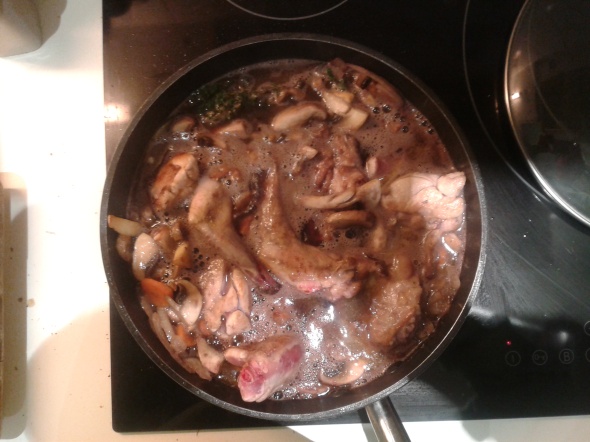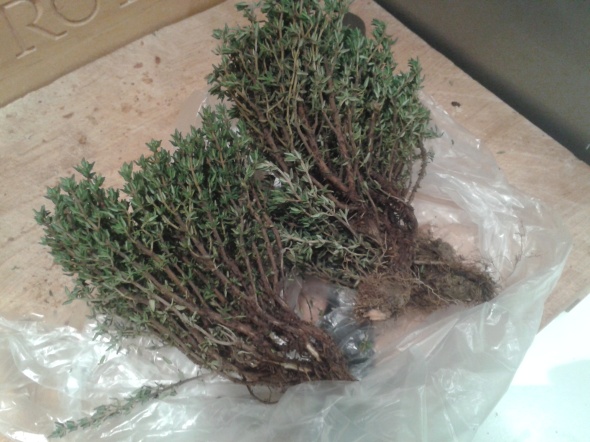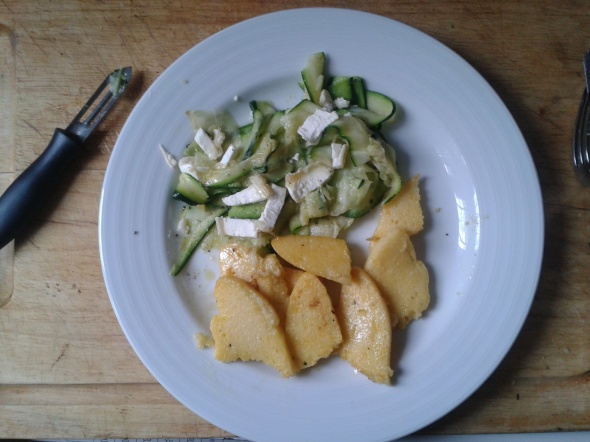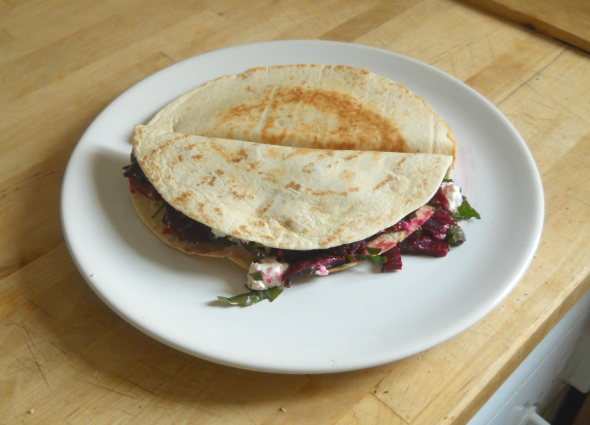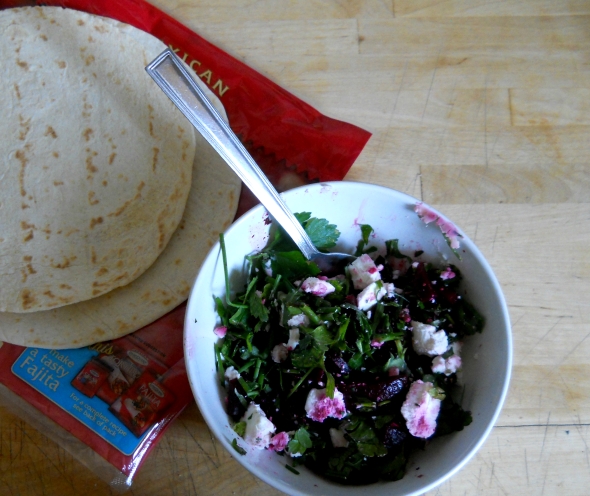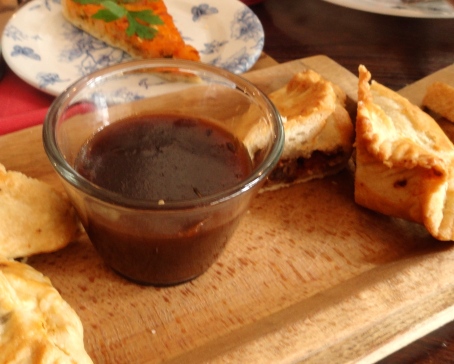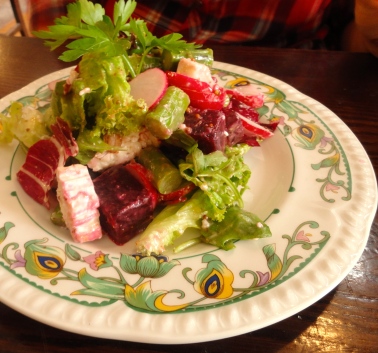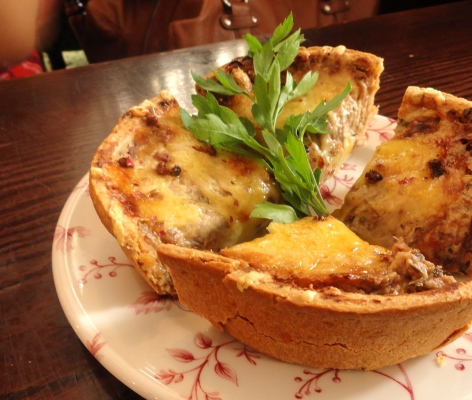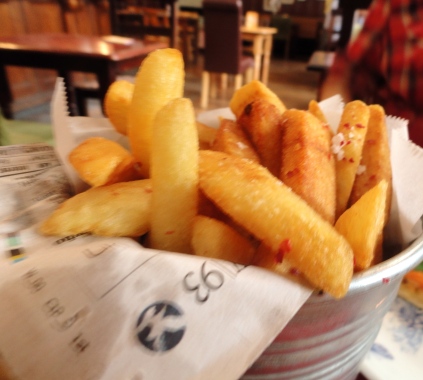Red Wine And Rabbit Stew With Polenta, And Leftovers
Posted: November 13, 2012 Filed under: Eating Paris, Recipes | Tags: comfort food, easy to make, French, goats cheese, mushrooms, polenta, rabbit, stew, wine 2 CommentsI know rabbit might not be for everyone, and many of you will be thinking of this:
And not of this:
But I can assure you that rabbit meat is delicious… a bit like chicken (looks exactly like it…) but gamier. I recently spent a week at my parents’ house in Paris where rabbit meat is as common as chicken’s and was presented with two rabbits to cook for dinner. I had never cooked it and did not have many ingredients so decided to go for something I know how to do well: a wine stew. I mean you can never go wrong with wine and meat… add some butter and it’s heaven!
For this recipe you will need (enough for five people)
– Two rabbits cut in smallish pieces (ask your butcher to do it, it’s usually in six pieces)
– Two carrots, minced.
– An onion, chopped.
– 300 grams of mushrooms, roughly chopped (preferably a mix of nutty mushrooms).
– Two bunches of thyme.
– Half a bottle of wine (pour the rest into a glass and drink it to get over the fact you’re eating a cute bunny).
– A lot of butter
Start by adding a knob of butter to a pan and brown the rabbit pieces. Reserve and do the same with the mushrooms in batches so they brown but don’t become mushy. Put them aside with the rabbit and add more butter to the pan. Add the onion and carrots and sweat them for 5-10 minutes. When they become soft, turn up the heat and add the wine and the thyme. You can also add a bay leaf at this point.
Let the wine reduce to half and then add the rabbit and the mushrooms. Make sure they are covered and add water if needed. Season with salt and pepper and let cook for at least 45 minutes on very low heat, with a lid on. When the meat looks like it’s cooked and almost falling off the bone take the lid off to let it reduce. Right now is the time to prepare the polenta. If you are experienced you can have a go at polenta flour which has too cook for 45 minutes with constant turning and gives you an arm ache and possibly some burns. If you are not an experienced Italian grandma, grab a good quality semi-ready polenta and follow the instructions. When the polenta is almost cooked add some cream or ricotta cheese and some parmesan. Season with salt and pepper and serve the stew over it.
The next day, if you are lucky to have some stew and polenta left, serve them together. If like me all you had is polenta, fry it in a pan with some butter until it’s crispy. For the courgette, slice it really thinly (with a peeler or a mandolin) fry it for 2-3 minutes in some butter and sprinkle it with salt, pepper, good olive oil and goat’s cheese. And there you go: a really easy and healthy second meal after the indulgence of rabbit and wine.
(Sorry for the low quality pictures, I only had my phone)
(Non-Mexican) Quesadillas
Posted: October 22, 2012 Filed under: Recipes | Tags: beetroot, feta, goats cheese, quick Leave a commentI know Quesadillas are technically Mexican, but the whole idea is simply cheese and some other ingredients trapped inside a tortilla to create melted awesomeness. I took this idea really liberally and made quesadillas with goat’s cheese, feta, beetroot and chopped herbs. Yes I am probably as far as I could be from real quesadillas, but it was really good and sometimes you just have to use what’s left in the fridge.
This can hardly be called a recipe but you will need:
- Goat’s cheese (the crumbly kind)
- Feta cheese (blue cheese would be amazing too now that I think of it…)
- Beetroot
- Chopped herbs (I had chives, parsley and wild rocket).
- Tortillas (fresh corn ones if you can, it tastes nothing like the Old El Paso/Sainsbury’s/Discovery flour tortillas – sadly I only had that kind this time).
Start by heating up a non-stick frying pan. Throw a tortilla in there (no oil or butter!) and leave it until golden. Turn it around and start adding the cheeses. On top of the cheese add the beetroot and the chopped herbs. Fold the tortilla in two and make sure it is gold on both sides. To serve, I like to cut the quesadillas in triangles and dip them in some kind of salsa/sour cream. Voila, easy, healthy lunch in 10 minutes or less (I am competing with Mr Oliver here!).
Review – British tapas at The Somers Town Coffee House
Posted: August 22, 2012 Filed under: Eating London | Tags: asparagus, beetroot, British, chips, Euston, gastropub, goats cheese, pastie, potted crab, salmon, Tapas Leave a commentHidden away in the rather anonymous and uncharming area between Euston and King’s Cross sits Somers Town Coffee house, an unlikely named gastropub specialising in British tapas. “That sounds odd”, the Salted cod said when I told her, but in fact it is carried off very well. The pub in itself is very pretty inside, with sturdy tables, old school armchairs and a door hidden in a bookshelf for the curious (if you dare open it and walk down the staircase you may be rewarded an invite to their “secret” supperclub) and there’s also a beer garden outside.
Me and my friend shared six tapas dishes and an excellent bottle of Rioja (there are some Tuesday lunch luxuries only dissertation writing can warrant) which came to about £25 each, so it’s not a very cheap place. But some of the dishes were absolutely fabulous. I found a favourite in the rather blandly named Cheese and onion pie, which was incredibly rich and sweet, with a heavy note of caramelised onion and creamy, light cheddar cheese. Potted crab was also lovely, with tender crab and shrimp spreading out coarsely on the different coloured toast. The salad with asparagus, goats cheese and beetroot was simple but delicious, sampling the best of seasonal without making a fuss. We also had a salmon and prawn tart wich was strong and fresh the way only cooked smoked salmon is, with strong hints of dill.
The only let-down was the beef, stilton and stout pasties which had way too much pasty on them and were too dry, with no note of stilton. The jus that came with them was sweet and lovely, and complimented other parts of our dishes well. Since we were hungry we also opted for chips as one of the plates, which were perfectly fine, especially with the jus from the steak pasties, but being… chips, there wasn’t that much to wow us about them.
All in all, it was a lovely eating experience, and we both walked out full and content. This is a good way of sampling little bits of classic British food and when I come back (and I hope I will) I’d love to try the gourmet scotch egg, the smoked applewood chunks, de-shelled popcorn mussels and the marinated pork belly lollipops. If I add that smooth bottle of Rioja, maybe I’ll actually dare enter the bookshelf staircase for the supperclub. 7,5 meatballs out of 10.
Somers town Coffee House can be found here on the map:
Homemade Pizza – The Salted Cod cooks for the Meatball
Posted: February 5, 2012 Filed under: Recipes | Tags: caramelised onion, chorizo, goats cheese, mozzarella, parma ham, Pizza, tomato sauce 11 CommentsToday I will be hosting a dinner at my house with, amongst others, Miss Meatball herself as my guest. Therefore, today you are getting both a recipe and a review of the meal. This post should be called: how to make a perfect pizza, then go on to burn your friend’s finger, destroy your oven, cook pizza in a frying pan with a wok on top, and then revive the oven and make really good pizzas again. So, skip the burning your friend/destroying the oven bit and make really easy home-made pizza.
For the dough, you will need:- Self-raising flour (good flour!)
- Warm water
- Olive Oil
- Salt
This pizza dough needs to rise for a few hours, so it’s best made the night before or the day before, you want it to rise as much as you can. I don’t really measure anything for this recipe and just kind of add as I go. You should probably be doing something like 200g of flour and 30cl of water for about two big pizzas, but it’s easier to measure it by looking at it. So you start by putting the flour in a bowl and making a little hole in the middle. Then you start adding the warm water, little by little and mixing in the flour and the water with a wooden spoon. Do this until the dough is mixed and can be kneaded with your hands.
Move to a dry surface and knead for 10 mins, adding salt little by little so it mixes well in the dough while you’re kneading. Form the dough into a ball-shape and rub olive oil all over. Put it a bowl which has previously been rubbed with olive oil, cover with a tea towel or any fabric you have in hand and let it rest for a minimum of three hours. While the dough is rising go buy some toppings and start making some tomato sauce. Our first pizza was made of tomato sauce, parma ham, caramelised onions and goats cheese, so I’ll give the recipe for the sauce and the caramelised onions.
For the sauce you will need:
- 1 tin of good quality chopped/whole tomatoes (if you’re a student like me it’s a good idea to buy them in bulk when they’re on a deal at your local supermarket as it really makes a difference to have good quality tinned tomatoes).
- half a glass of red wine (plus more to drink while you’re making the sauce).
- olive oil
- garlic, finely chopped (as much as you wish, I usually go for three cloves).
- 1 onion, finely chopped
- good quality tomato paste (they have some really good ones in waitrose, and they last forever).
- salt & pepper
Start by chopping the onions and frying them in a little bit of olive oil, on a medium temperature, for about 10 mins until they become soft. Add the chopped garlic, turn the heat up a bit and fry, while constantly stirring (so the garlic doesn’t burn) for about 3 minutes, just enough for the garlic to release its flavour. Turn the heat up a bit more, add the wine and let the alcohol evaporate. Add the chopped tomatoes, half a glass of water, and a tablespoon of tomato paste. Bring to a boil, turn the heat down to very low, put a cover on and simmer for as long as you can. Season with salt and pepper, and maybe add a bit of sugar if the sauce tastes too acidic. This sauce gets better with time, so ideally you want to cook it for 1h30 hours. You can also double or triple the recipe and freeze it. While the sauce is bubbling on the side you can start making the caramelised onions.
You will need:
- 3 red or yellow onions, or shallots if you’re feeling fancy (white onions don’t really work)
- A non-stick pan
- Olive oil
- some balsamic vinegar or balsamic glaze (this is optional).
Start by chopping the onions into strips, it doesn’t need to look perfect. Fry them in olive oil on a high/medium heat for 5 minutes then lower the heat to the slowest setting on your hob and let it cook by itself, stirring from time to time. You can add the balsamic vinegar or balsamic glaze to accelerate the process or you can just let it cook until it looks dark and well caramelised on its own.
When all this is done and the dough has doubled in size, you can start kneading again (or you can find someone with strong arms and hands aka. Miss Meatball herself to do it for you). Knead until the dough is smooth and elastic. Then you need to start rolling the dough using a rolling pin (or an old wine bottle if you’re a lazy student like me). Roll it as thin as you can and transfer it to a sheet of tin foil. Your oven should be heated up to its maximum temperature, to simulate the heat of a pizza oven (although, if you have an oven like mine, it might overheat and die after half an hour, leaving you to make pizza on a frying pan and burning your friend’s hand in the process).
Start spreading the tomato sauce and add your toppings, leaving the cheese for last so it melts on top of everything. Now you can either put it in like that or fold it to make a calzone. Leave it in the oven until it’s crispy and all the toppings look cooked/melted. Serve with lots of wine and special Belgian beers 🙂
Now Miss Meatball’s review: This dough and sauce was delicious, so I am only going to comment on it by saying that this will be my dough recipe of choice for making home-made pizza next time. The sauce was dark and rich, and the dough resulted in thin, crispy beauties coming out of the oven (albeit in a asymmetrical sense perhaps). My favourite topping was the first mix, as the smooth goats cheese went so well against the salty crispiness of the parma ham and the sweetness of the caramelised onions. Drizzling a little bit of truffle oil on top of it made it the winner by me. However, the other guests seemed keener on the calzone with chorizo and lots and lots of mozzarella. It being in the shape of a calzone made it gooey and sumptuous and not the slightest dry. All in all, lovely thin pizzas. And making them provided us with plenty of action and entertainment.

